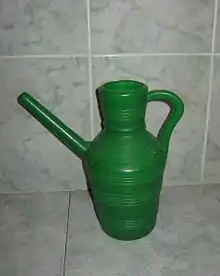Aftabeh
Aftabeh (/ɑːftɑːˈbɛ/ Persian: آفتابه), also called obdasta (Persian: ob – water and dasta – handle) is a pitcher made out of clay, copper, brass, or plastic which is used traditionally for purposes of hand washing, cleansing, and ablution.[1][2] Its overall shape is similar to a ewer with an angled spout protruding from its side, from where water is poured. It shares resemblance with lota and kindi in Indian culture.

Aftebehs are common in Iran, Azerbaijan, and Central Asian countries. In Uzbekistan, the vessel is mostly called obdasta, but the term oftoba is common in Namangan and Andijan regions. Aftabehs are called ibriq in Qashqadaryo Region.
Aftabeh is now mostly an accessory in toilets and used inside the bathroom alongside health faucets. Aftabeh has been used within Persia and the wider Central Asian region throughout history and many historical aftabehs, particularly elaborately decorated ones are on display at museums around the world as historical artifacts with cultural and artistic value.[3]
Aftabeh-Lagan
In Qajar era, it was customary for affluent families to have servants bring a set of brass or copper aftabeh-lagan (pitcher and wash basin) so everyone could wash their hands and face before food was served. Similarly, in rural areas of Central Asia guests are still offered an aftabeh (with a lagan or a basin) and a towel for washing hands before and after eating.[4]
There is a popular Persian proverb associated with aftabeh-lagan: "7 sets of aftabeh-lagan, but no lunch or dinner!" which refers to an empty show of opulence around a subject where the actual content is missing.
References
- Alberts, Robert Charles (1983). Social Structure and Culture Change in an Iranian Village, Volume 1. University of Wisconsin. p. 169.
- "Squat toilet in Iran". Retrieved 18 March 2020.
- "oldest aftabeh dating 2600 years". Rokna News Agency. 18 March 2020.
- Bacon, Elizabeth. E (1980). Central Asians under Russian Rule: A Study in Culture Change. Ithaca and London: Cornell University Press. p. 160-161. ISBN 0-8014-9211-4.
External links
- An aftabeh in Brooklyn Museum
- A decorated brass aftabeh with Persian motifs at National Museum of Scotland
- Finely engraved Qajar-era aftabeh at State Hermitage Museum, Saint Petersburg, Russia
- Decorated brass aftabeh with poetic and benedictory inscriptions at Victoria and Albert (V&A) Museum, London

